Plato's Metaphysics and Skepticism: Exploring Greek Skepticism
VerifiedAdded on 2022/05/13
|17
|5368
|168
Essay
AI Summary
This essay delves into Plato's metaphysics and skepticism, exploring his ideas on the nature of reality, knowledge, and the world. It begins by defining metaphysics and its importance in Plato's philosophy, particularly concerning the theory of Forms. The essay examines the problem of universals, Plato's concept of two worlds (particulars and universals), and the idea of perfection. It then explores the World of Forms, its characteristics, and how it relates to the physical world. The essay further discusses the myth of Demiurge and its role in the creation of the world. Finally, the essay focuses on Greek skepticism as a part of Plato's metaphysics, arguing that Plato's metaphysical learning is crucial for understanding various forms of skepticism. The essay aims to provide a detailed explanation of Plato's key concepts and their relevance to philosophical skepticism.
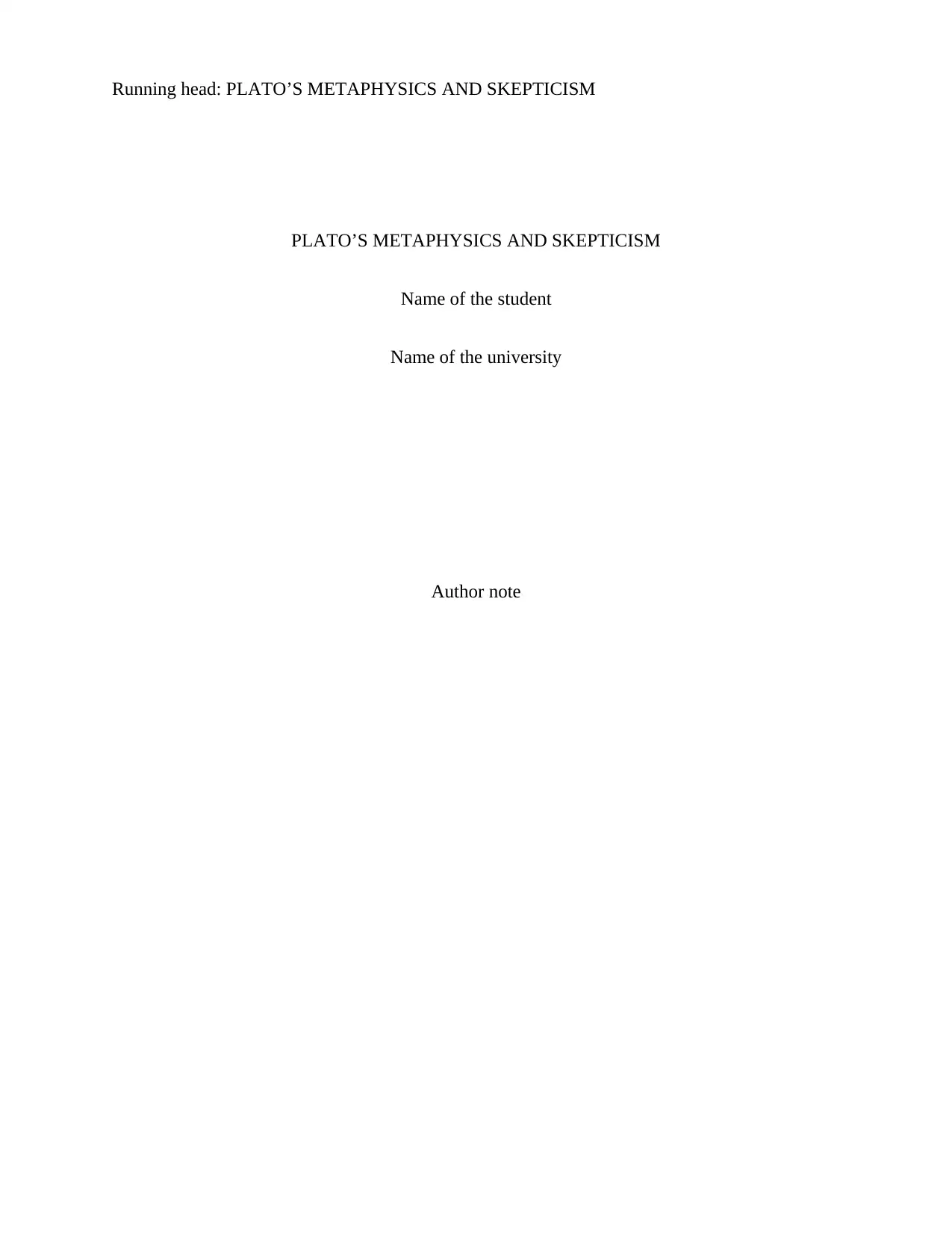
Running head: PLATO’S METAPHYSICS AND SKEPTICISM
PLATO’S METAPHYSICS AND SKEPTICISM
Name of the student
Name of the university
Author note
PLATO’S METAPHYSICS AND SKEPTICISM
Name of the student
Name of the university
Author note
Paraphrase This Document
Need a fresh take? Get an instant paraphrase of this document with our AI Paraphraser
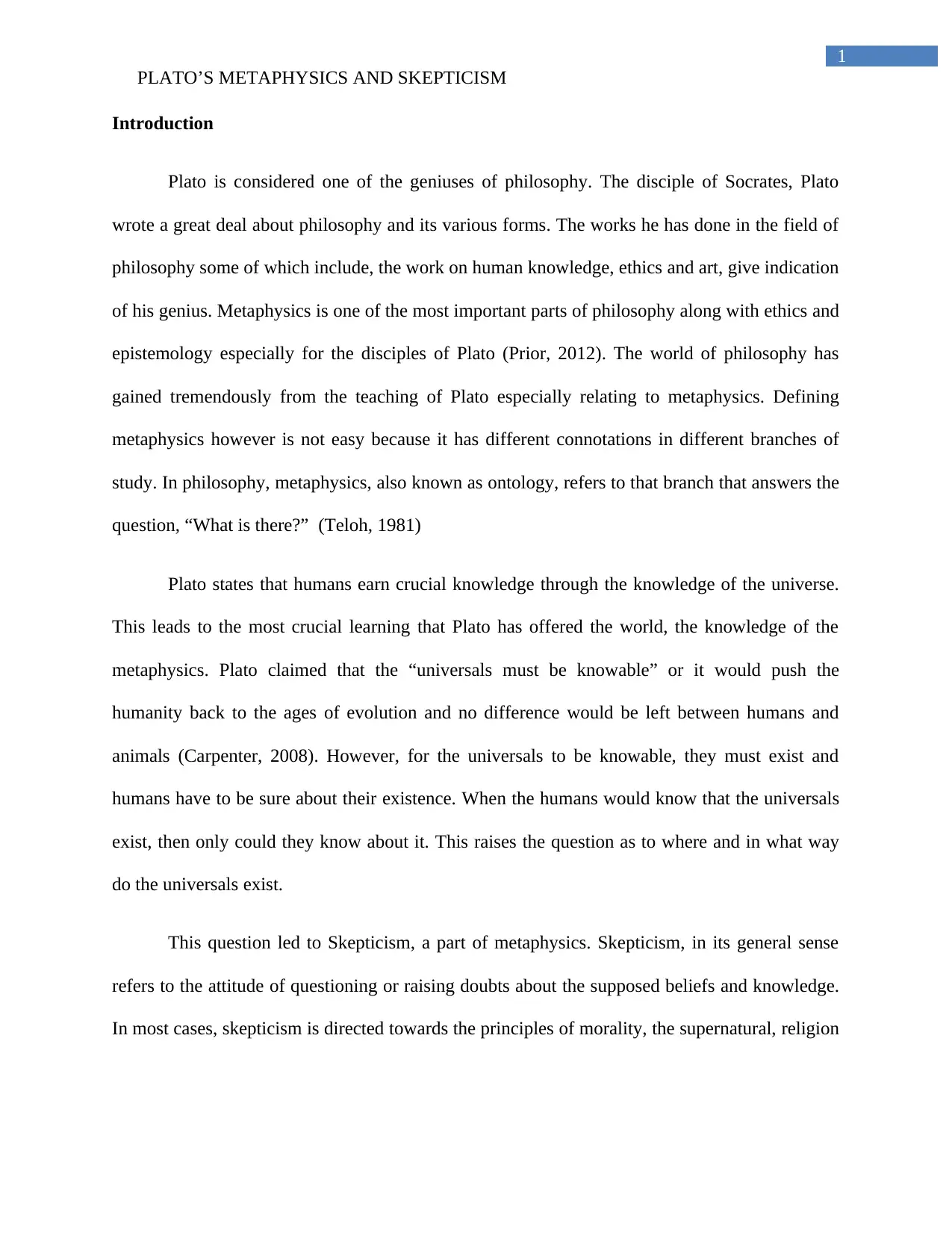
1
PLATO’S METAPHYSICS AND SKEPTICISM
Introduction
Plato is considered one of the geniuses of philosophy. The disciple of Socrates, Plato
wrote a great deal about philosophy and its various forms. The works he has done in the field of
philosophy some of which include, the work on human knowledge, ethics and art, give indication
of his genius. Metaphysics is one of the most important parts of philosophy along with ethics and
epistemology especially for the disciples of Plato (Prior, 2012). The world of philosophy has
gained tremendously from the teaching of Plato especially relating to metaphysics. Defining
metaphysics however is not easy because it has different connotations in different branches of
study. In philosophy, metaphysics, also known as ontology, refers to that branch that answers the
question, “What is there?” (Teloh, 1981)
Plato states that humans earn crucial knowledge through the knowledge of the universe.
This leads to the most crucial learning that Plato has offered the world, the knowledge of the
metaphysics. Plato claimed that the “universals must be knowable” or it would push the
humanity back to the ages of evolution and no difference would be left between humans and
animals (Carpenter, 2008). However, for the universals to be knowable, they must exist and
humans have to be sure about their existence. When the humans would know that the universals
exist, then only could they know about it. This raises the question as to where and in what way
do the universals exist.
This question led to Skepticism, a part of metaphysics. Skepticism, in its general sense
refers to the attitude of questioning or raising doubts about the supposed beliefs and knowledge.
In most cases, skepticism is directed towards the principles of morality, the supernatural, religion
PLATO’S METAPHYSICS AND SKEPTICISM
Introduction
Plato is considered one of the geniuses of philosophy. The disciple of Socrates, Plato
wrote a great deal about philosophy and its various forms. The works he has done in the field of
philosophy some of which include, the work on human knowledge, ethics and art, give indication
of his genius. Metaphysics is one of the most important parts of philosophy along with ethics and
epistemology especially for the disciples of Plato (Prior, 2012). The world of philosophy has
gained tremendously from the teaching of Plato especially relating to metaphysics. Defining
metaphysics however is not easy because it has different connotations in different branches of
study. In philosophy, metaphysics, also known as ontology, refers to that branch that answers the
question, “What is there?” (Teloh, 1981)
Plato states that humans earn crucial knowledge through the knowledge of the universe.
This leads to the most crucial learning that Plato has offered the world, the knowledge of the
metaphysics. Plato claimed that the “universals must be knowable” or it would push the
humanity back to the ages of evolution and no difference would be left between humans and
animals (Carpenter, 2008). However, for the universals to be knowable, they must exist and
humans have to be sure about their existence. When the humans would know that the universals
exist, then only could they know about it. This raises the question as to where and in what way
do the universals exist.
This question led to Skepticism, a part of metaphysics. Skepticism, in its general sense
refers to the attitude of questioning or raising doubts about the supposed beliefs and knowledge.
In most cases, skepticism is directed towards the principles of morality, the supernatural, religion
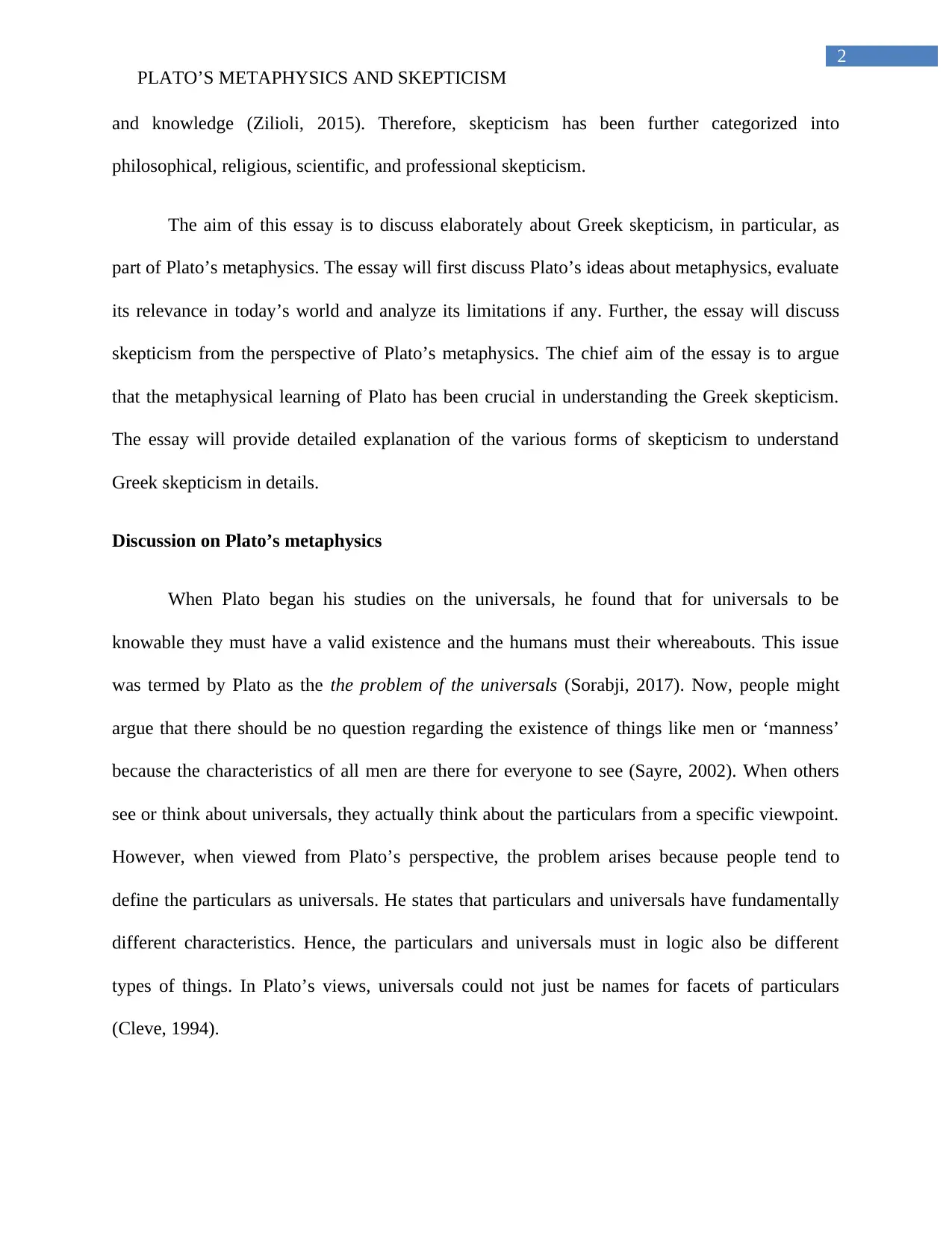
2
PLATO’S METAPHYSICS AND SKEPTICISM
and knowledge (Zilioli, 2015). Therefore, skepticism has been further categorized into
philosophical, religious, scientific, and professional skepticism.
The aim of this essay is to discuss elaborately about Greek skepticism, in particular, as
part of Plato’s metaphysics. The essay will first discuss Plato’s ideas about metaphysics, evaluate
its relevance in today’s world and analyze its limitations if any. Further, the essay will discuss
skepticism from the perspective of Plato’s metaphysics. The chief aim of the essay is to argue
that the metaphysical learning of Plato has been crucial in understanding the Greek skepticism.
The essay will provide detailed explanation of the various forms of skepticism to understand
Greek skepticism in details.
Discussion on Plato’s metaphysics
When Plato began his studies on the universals, he found that for universals to be
knowable they must have a valid existence and the humans must their whereabouts. This issue
was termed by Plato as the the problem of the universals (Sorabji, 2017). Now, people might
argue that there should be no question regarding the existence of things like men or ‘manness’
because the characteristics of all men are there for everyone to see (Sayre, 2002). When others
see or think about universals, they actually think about the particulars from a specific viewpoint.
However, when viewed from Plato’s perspective, the problem arises because people tend to
define the particulars as universals. He states that particulars and universals have fundamentally
different characteristics. Hence, the particulars and universals must in logic also be different
types of things. In Plato’s views, universals could not just be names for facets of particulars
(Cleve, 1994).
PLATO’S METAPHYSICS AND SKEPTICISM
and knowledge (Zilioli, 2015). Therefore, skepticism has been further categorized into
philosophical, religious, scientific, and professional skepticism.
The aim of this essay is to discuss elaborately about Greek skepticism, in particular, as
part of Plato’s metaphysics. The essay will first discuss Plato’s ideas about metaphysics, evaluate
its relevance in today’s world and analyze its limitations if any. Further, the essay will discuss
skepticism from the perspective of Plato’s metaphysics. The chief aim of the essay is to argue
that the metaphysical learning of Plato has been crucial in understanding the Greek skepticism.
The essay will provide detailed explanation of the various forms of skepticism to understand
Greek skepticism in details.
Discussion on Plato’s metaphysics
When Plato began his studies on the universals, he found that for universals to be
knowable they must have a valid existence and the humans must their whereabouts. This issue
was termed by Plato as the the problem of the universals (Sorabji, 2017). Now, people might
argue that there should be no question regarding the existence of things like men or ‘manness’
because the characteristics of all men are there for everyone to see (Sayre, 2002). When others
see or think about universals, they actually think about the particulars from a specific viewpoint.
However, when viewed from Plato’s perspective, the problem arises because people tend to
define the particulars as universals. He states that particulars and universals have fundamentally
different characteristics. Hence, the particulars and universals must in logic also be different
types of things. In Plato’s views, universals could not just be names for facets of particulars
(Cleve, 1994).
⊘ This is a preview!⊘
Do you want full access?
Subscribe today to unlock all pages.

Trusted by 1+ million students worldwide
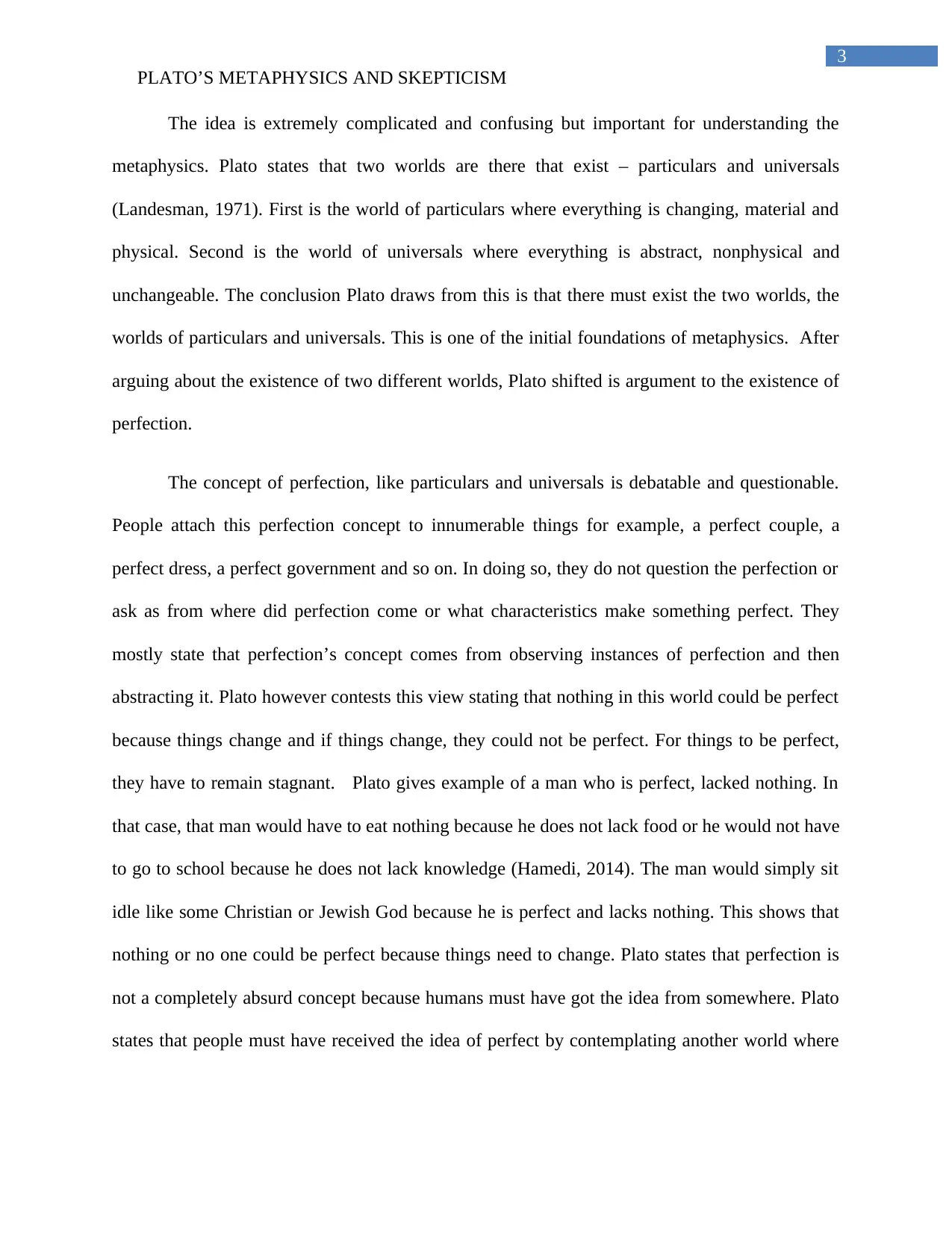
3
PLATO’S METAPHYSICS AND SKEPTICISM
The idea is extremely complicated and confusing but important for understanding the
metaphysics. Plato states that two worlds are there that exist – particulars and universals
(Landesman, 1971). First is the world of particulars where everything is changing, material and
physical. Second is the world of universals where everything is abstract, nonphysical and
unchangeable. The conclusion Plato draws from this is that there must exist the two worlds, the
worlds of particulars and universals. This is one of the initial foundations of metaphysics. After
arguing about the existence of two different worlds, Plato shifted is argument to the existence of
perfection.
The concept of perfection, like particulars and universals is debatable and questionable.
People attach this perfection concept to innumerable things for example, a perfect couple, a
perfect dress, a perfect government and so on. In doing so, they do not question the perfection or
ask as from where did perfection come or what characteristics make something perfect. They
mostly state that perfection’s concept comes from observing instances of perfection and then
abstracting it. Plato however contests this view stating that nothing in this world could be perfect
because things change and if things change, they could not be perfect. For things to be perfect,
they have to remain stagnant. Plato gives example of a man who is perfect, lacked nothing. In
that case, that man would have to eat nothing because he does not lack food or he would not have
to go to school because he does not lack knowledge (Hamedi, 2014). The man would simply sit
idle like some Christian or Jewish God because he is perfect and lacks nothing. This shows that
nothing or no one could be perfect because things need to change. Plato states that perfection is
not a completely absurd concept because humans must have got the idea from somewhere. Plato
states that people must have received the idea of perfect by contemplating another world where
PLATO’S METAPHYSICS AND SKEPTICISM
The idea is extremely complicated and confusing but important for understanding the
metaphysics. Plato states that two worlds are there that exist – particulars and universals
(Landesman, 1971). First is the world of particulars where everything is changing, material and
physical. Second is the world of universals where everything is abstract, nonphysical and
unchangeable. The conclusion Plato draws from this is that there must exist the two worlds, the
worlds of particulars and universals. This is one of the initial foundations of metaphysics. After
arguing about the existence of two different worlds, Plato shifted is argument to the existence of
perfection.
The concept of perfection, like particulars and universals is debatable and questionable.
People attach this perfection concept to innumerable things for example, a perfect couple, a
perfect dress, a perfect government and so on. In doing so, they do not question the perfection or
ask as from where did perfection come or what characteristics make something perfect. They
mostly state that perfection’s concept comes from observing instances of perfection and then
abstracting it. Plato however contests this view stating that nothing in this world could be perfect
because things change and if things change, they could not be perfect. For things to be perfect,
they have to remain stagnant. Plato gives example of a man who is perfect, lacked nothing. In
that case, that man would have to eat nothing because he does not lack food or he would not have
to go to school because he does not lack knowledge (Hamedi, 2014). The man would simply sit
idle like some Christian or Jewish God because he is perfect and lacks nothing. This shows that
nothing or no one could be perfect because things need to change. Plato states that perfection is
not a completely absurd concept because humans must have got the idea from somewhere. Plato
states that people must have received the idea of perfect by contemplating another world where
Paraphrase This Document
Need a fresh take? Get an instant paraphrase of this document with our AI Paraphraser
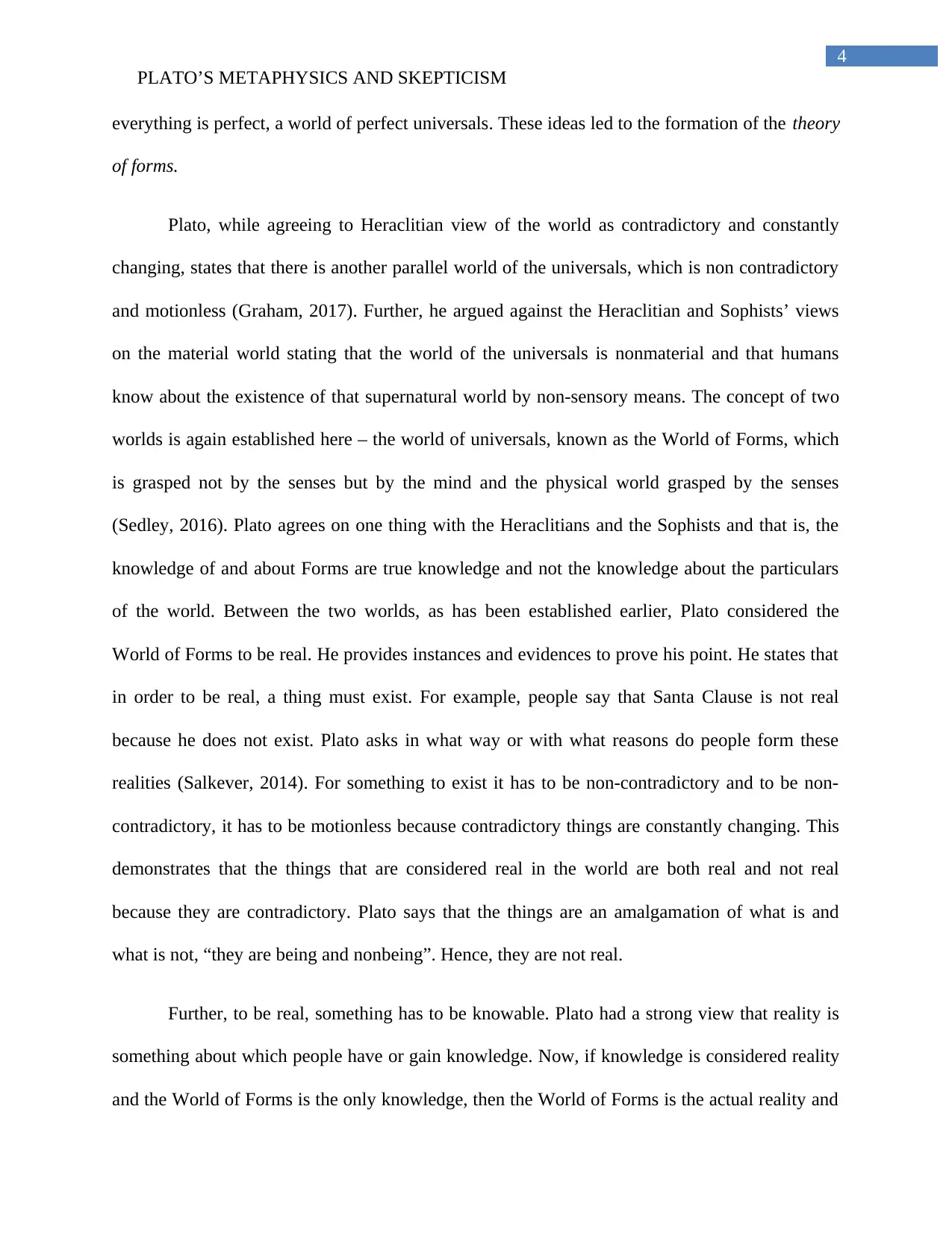
4
PLATO’S METAPHYSICS AND SKEPTICISM
everything is perfect, a world of perfect universals. These ideas led to the formation of the theory
of forms.
Plato, while agreeing to Heraclitian view of the world as contradictory and constantly
changing, states that there is another parallel world of the universals, which is non contradictory
and motionless (Graham, 2017). Further, he argued against the Heraclitian and Sophists’ views
on the material world stating that the world of the universals is nonmaterial and that humans
know about the existence of that supernatural world by non-sensory means. The concept of two
worlds is again established here – the world of universals, known as the World of Forms, which
is grasped not by the senses but by the mind and the physical world grasped by the senses
(Sedley, 2016). Plato agrees on one thing with the Heraclitians and the Sophists and that is, the
knowledge of and about Forms are true knowledge and not the knowledge about the particulars
of the world. Between the two worlds, as has been established earlier, Plato considered the
World of Forms to be real. He provides instances and evidences to prove his point. He states that
in order to be real, a thing must exist. For example, people say that Santa Clause is not real
because he does not exist. Plato asks in what way or with what reasons do people form these
realities (Salkever, 2014). For something to exist it has to be non-contradictory and to be non-
contradictory, it has to be motionless because contradictory things are constantly changing. This
demonstrates that the things that are considered real in the world are both real and not real
because they are contradictory. Plato says that the things are an amalgamation of what is and
what is not, “they are being and nonbeing”. Hence, they are not real.
Further, to be real, something has to be knowable. Plato had a strong view that reality is
something about which people have or gain knowledge. Now, if knowledge is considered reality
and the World of Forms is the only knowledge, then the World of Forms is the actual reality and
PLATO’S METAPHYSICS AND SKEPTICISM
everything is perfect, a world of perfect universals. These ideas led to the formation of the theory
of forms.
Plato, while agreeing to Heraclitian view of the world as contradictory and constantly
changing, states that there is another parallel world of the universals, which is non contradictory
and motionless (Graham, 2017). Further, he argued against the Heraclitian and Sophists’ views
on the material world stating that the world of the universals is nonmaterial and that humans
know about the existence of that supernatural world by non-sensory means. The concept of two
worlds is again established here – the world of universals, known as the World of Forms, which
is grasped not by the senses but by the mind and the physical world grasped by the senses
(Sedley, 2016). Plato agrees on one thing with the Heraclitians and the Sophists and that is, the
knowledge of and about Forms are true knowledge and not the knowledge about the particulars
of the world. Between the two worlds, as has been established earlier, Plato considered the
World of Forms to be real. He provides instances and evidences to prove his point. He states that
in order to be real, a thing must exist. For example, people say that Santa Clause is not real
because he does not exist. Plato asks in what way or with what reasons do people form these
realities (Salkever, 2014). For something to exist it has to be non-contradictory and to be non-
contradictory, it has to be motionless because contradictory things are constantly changing. This
demonstrates that the things that are considered real in the world are both real and not real
because they are contradictory. Plato says that the things are an amalgamation of what is and
what is not, “they are being and nonbeing”. Hence, they are not real.
Further, to be real, something has to be knowable. Plato had a strong view that reality is
something about which people have or gain knowledge. Now, if knowledge is considered reality
and the World of Forms is the only knowledge, then the World of Forms is the actual reality and
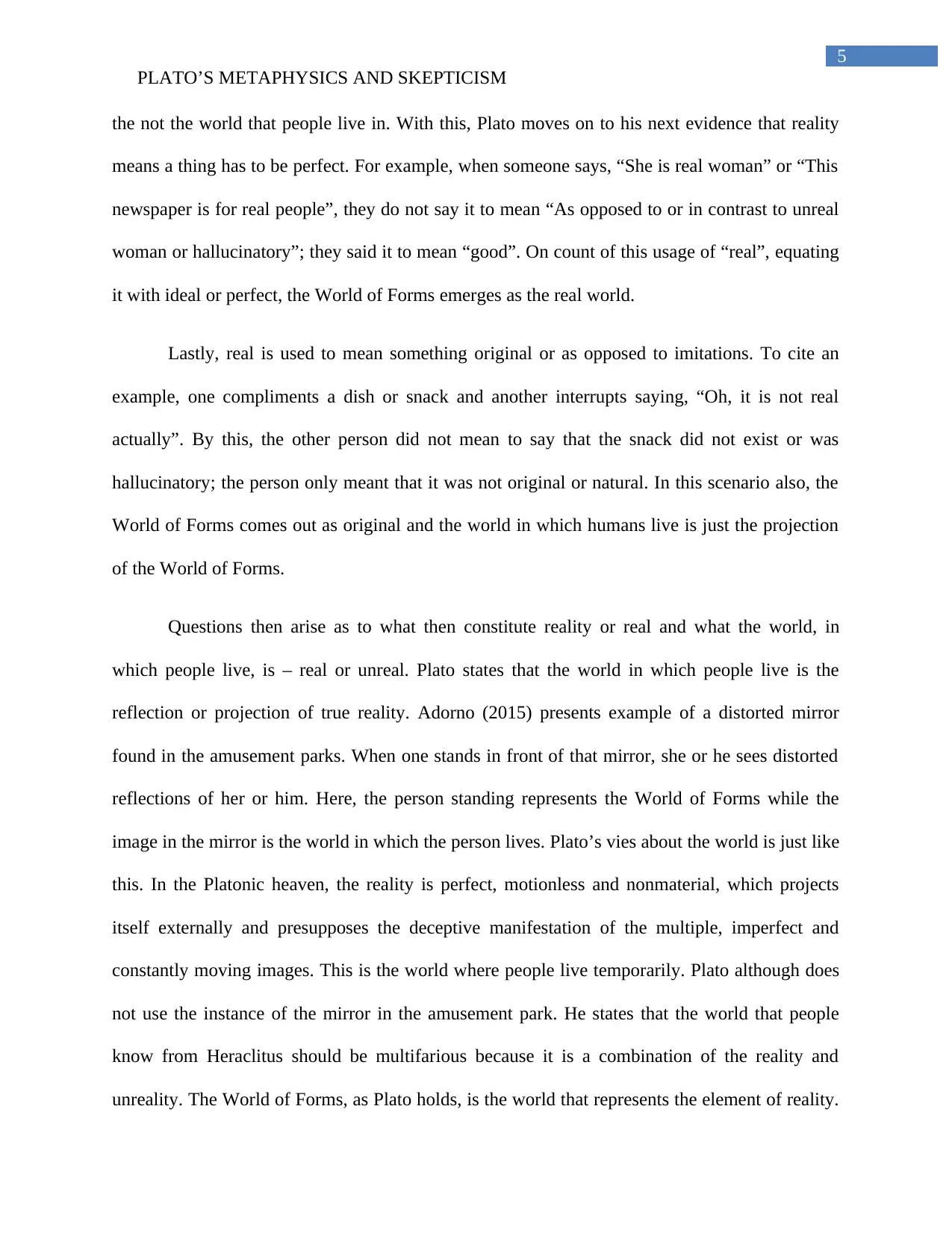
5
PLATO’S METAPHYSICS AND SKEPTICISM
the not the world that people live in. With this, Plato moves on to his next evidence that reality
means a thing has to be perfect. For example, when someone says, “She is real woman” or “This
newspaper is for real people”, they do not say it to mean “As opposed to or in contrast to unreal
woman or hallucinatory”; they said it to mean “good”. On count of this usage of “real”, equating
it with ideal or perfect, the World of Forms emerges as the real world.
Lastly, real is used to mean something original or as opposed to imitations. To cite an
example, one compliments a dish or snack and another interrupts saying, “Oh, it is not real
actually”. By this, the other person did not mean to say that the snack did not exist or was
hallucinatory; the person only meant that it was not original or natural. In this scenario also, the
World of Forms comes out as original and the world in which humans live is just the projection
of the World of Forms.
Questions then arise as to what then constitute reality or real and what the world, in
which people live, is – real or unreal. Plato states that the world in which people live is the
reflection or projection of true reality. Adorno (2015) presents example of a distorted mirror
found in the amusement parks. When one stands in front of that mirror, she or he sees distorted
reflections of her or him. Here, the person standing represents the World of Forms while the
image in the mirror is the world in which the person lives. Plato’s vies about the world is just like
this. In the Platonic heaven, the reality is perfect, motionless and nonmaterial, which projects
itself externally and presupposes the deceptive manifestation of the multiple, imperfect and
constantly moving images. This is the world where people live temporarily. Plato although does
not use the instance of the mirror in the amusement park. He states that the world that people
know from Heraclitus should be multifarious because it is a combination of the reality and
unreality. The World of Forms, as Plato holds, is the world that represents the element of reality.
PLATO’S METAPHYSICS AND SKEPTICISM
the not the world that people live in. With this, Plato moves on to his next evidence that reality
means a thing has to be perfect. For example, when someone says, “She is real woman” or “This
newspaper is for real people”, they do not say it to mean “As opposed to or in contrast to unreal
woman or hallucinatory”; they said it to mean “good”. On count of this usage of “real”, equating
it with ideal or perfect, the World of Forms emerges as the real world.
Lastly, real is used to mean something original or as opposed to imitations. To cite an
example, one compliments a dish or snack and another interrupts saying, “Oh, it is not real
actually”. By this, the other person did not mean to say that the snack did not exist or was
hallucinatory; the person only meant that it was not original or natural. In this scenario also, the
World of Forms comes out as original and the world in which humans live is just the projection
of the World of Forms.
Questions then arise as to what then constitute reality or real and what the world, in
which people live, is – real or unreal. Plato states that the world in which people live is the
reflection or projection of true reality. Adorno (2015) presents example of a distorted mirror
found in the amusement parks. When one stands in front of that mirror, she or he sees distorted
reflections of her or him. Here, the person standing represents the World of Forms while the
image in the mirror is the world in which the person lives. Plato’s vies about the world is just like
this. In the Platonic heaven, the reality is perfect, motionless and nonmaterial, which projects
itself externally and presupposes the deceptive manifestation of the multiple, imperfect and
constantly moving images. This is the world where people live temporarily. Plato although does
not use the instance of the mirror in the amusement park. He states that the world that people
know from Heraclitus should be multifarious because it is a combination of the reality and
unreality. The World of Forms, as Plato holds, is the world that represents the element of reality.
⊘ This is a preview!⊘
Do you want full access?
Subscribe today to unlock all pages.

Trusted by 1+ million students worldwide
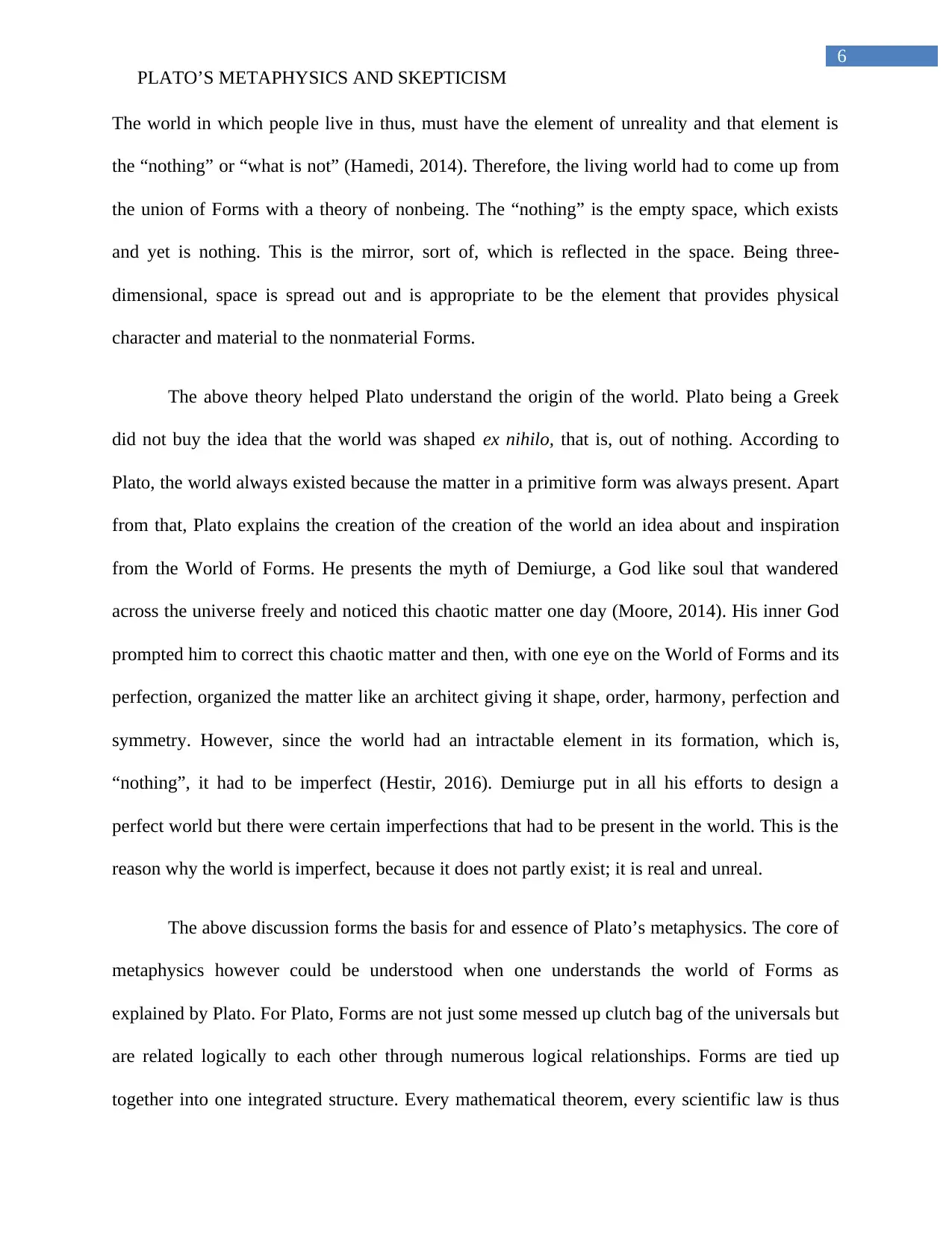
6
PLATO’S METAPHYSICS AND SKEPTICISM
The world in which people live in thus, must have the element of unreality and that element is
the “nothing” or “what is not” (Hamedi, 2014). Therefore, the living world had to come up from
the union of Forms with a theory of nonbeing. The “nothing” is the empty space, which exists
and yet is nothing. This is the mirror, sort of, which is reflected in the space. Being three-
dimensional, space is spread out and is appropriate to be the element that provides physical
character and material to the nonmaterial Forms.
The above theory helped Plato understand the origin of the world. Plato being a Greek
did not buy the idea that the world was shaped ex nihilo, that is, out of nothing. According to
Plato, the world always existed because the matter in a primitive form was always present. Apart
from that, Plato explains the creation of the creation of the world an idea about and inspiration
from the World of Forms. He presents the myth of Demiurge, a God like soul that wandered
across the universe freely and noticed this chaotic matter one day (Moore, 2014). His inner God
prompted him to correct this chaotic matter and then, with one eye on the World of Forms and its
perfection, organized the matter like an architect giving it shape, order, harmony, perfection and
symmetry. However, since the world had an intractable element in its formation, which is,
“nothing”, it had to be imperfect (Hestir, 2016). Demiurge put in all his efforts to design a
perfect world but there were certain imperfections that had to be present in the world. This is the
reason why the world is imperfect, because it does not partly exist; it is real and unreal.
The above discussion forms the basis for and essence of Plato’s metaphysics. The core of
metaphysics however could be understood when one understands the world of Forms as
explained by Plato. For Plato, Forms are not just some messed up clutch bag of the universals but
are related logically to each other through numerous logical relationships. Forms are tied up
together into one integrated structure. Every mathematical theorem, every scientific law is thus
PLATO’S METAPHYSICS AND SKEPTICISM
The world in which people live in thus, must have the element of unreality and that element is
the “nothing” or “what is not” (Hamedi, 2014). Therefore, the living world had to come up from
the union of Forms with a theory of nonbeing. The “nothing” is the empty space, which exists
and yet is nothing. This is the mirror, sort of, which is reflected in the space. Being three-
dimensional, space is spread out and is appropriate to be the element that provides physical
character and material to the nonmaterial Forms.
The above theory helped Plato understand the origin of the world. Plato being a Greek
did not buy the idea that the world was shaped ex nihilo, that is, out of nothing. According to
Plato, the world always existed because the matter in a primitive form was always present. Apart
from that, Plato explains the creation of the creation of the world an idea about and inspiration
from the World of Forms. He presents the myth of Demiurge, a God like soul that wandered
across the universe freely and noticed this chaotic matter one day (Moore, 2014). His inner God
prompted him to correct this chaotic matter and then, with one eye on the World of Forms and its
perfection, organized the matter like an architect giving it shape, order, harmony, perfection and
symmetry. However, since the world had an intractable element in its formation, which is,
“nothing”, it had to be imperfect (Hestir, 2016). Demiurge put in all his efforts to design a
perfect world but there were certain imperfections that had to be present in the world. This is the
reason why the world is imperfect, because it does not partly exist; it is real and unreal.
The above discussion forms the basis for and essence of Plato’s metaphysics. The core of
metaphysics however could be understood when one understands the world of Forms as
explained by Plato. For Plato, Forms are not just some messed up clutch bag of the universals but
are related logically to each other through numerous logical relationships. Forms are tied up
together into one integrated structure. Every mathematical theorem, every scientific law is thus
Paraphrase This Document
Need a fresh take? Get an instant paraphrase of this document with our AI Paraphraser
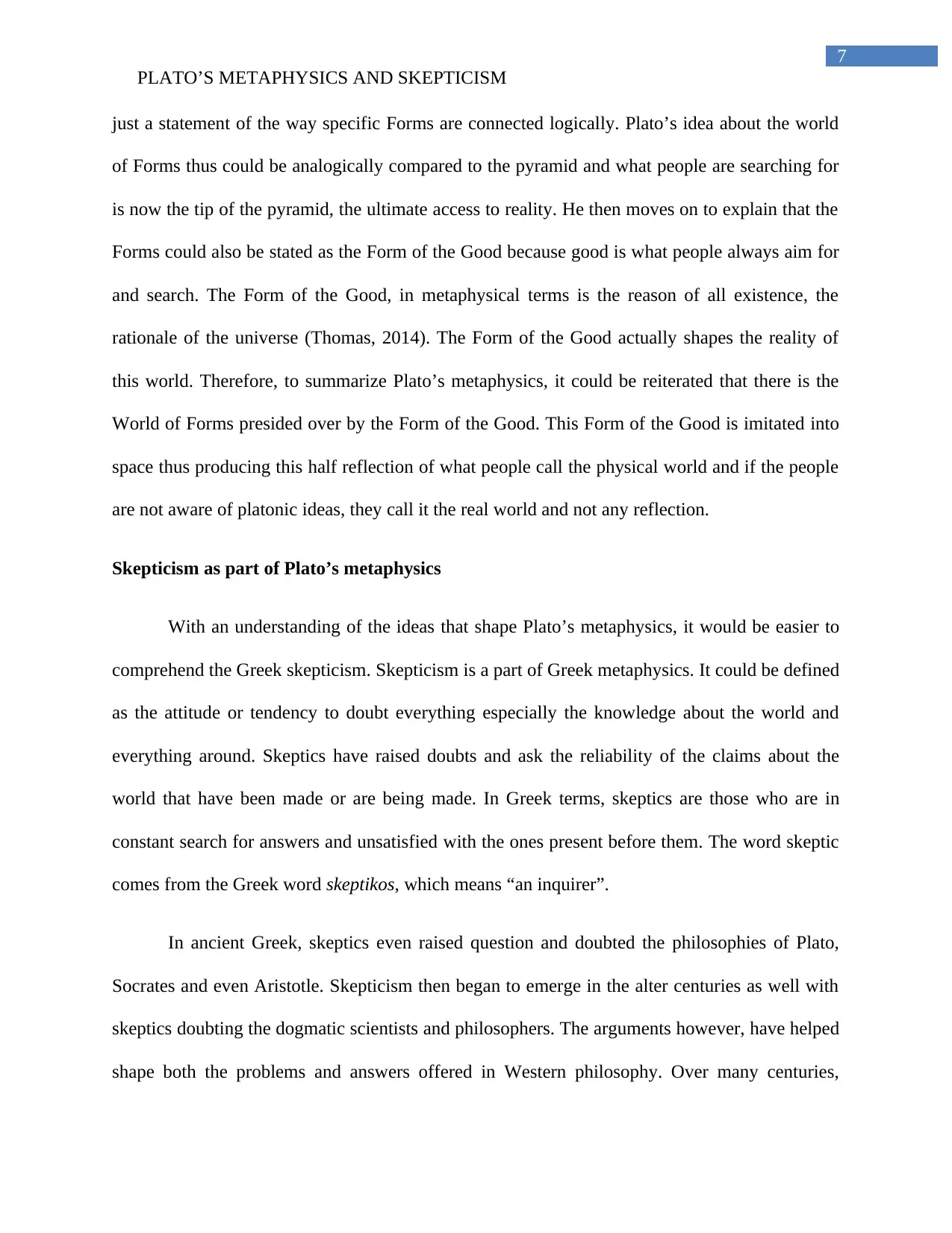
7
PLATO’S METAPHYSICS AND SKEPTICISM
just a statement of the way specific Forms are connected logically. Plato’s idea about the world
of Forms thus could be analogically compared to the pyramid and what people are searching for
is now the tip of the pyramid, the ultimate access to reality. He then moves on to explain that the
Forms could also be stated as the Form of the Good because good is what people always aim for
and search. The Form of the Good, in metaphysical terms is the reason of all existence, the
rationale of the universe (Thomas, 2014). The Form of the Good actually shapes the reality of
this world. Therefore, to summarize Plato’s metaphysics, it could be reiterated that there is the
World of Forms presided over by the Form of the Good. This Form of the Good is imitated into
space thus producing this half reflection of what people call the physical world and if the people
are not aware of platonic ideas, they call it the real world and not any reflection.
Skepticism as part of Plato’s metaphysics
With an understanding of the ideas that shape Plato’s metaphysics, it would be easier to
comprehend the Greek skepticism. Skepticism is a part of Greek metaphysics. It could be defined
as the attitude or tendency to doubt everything especially the knowledge about the world and
everything around. Skeptics have raised doubts and ask the reliability of the claims about the
world that have been made or are being made. In Greek terms, skeptics are those who are in
constant search for answers and unsatisfied with the ones present before them. The word skeptic
comes from the Greek word skeptikos, which means “an inquirer”.
In ancient Greek, skeptics even raised question and doubted the philosophies of Plato,
Socrates and even Aristotle. Skepticism then began to emerge in the alter centuries as well with
skeptics doubting the dogmatic scientists and philosophers. The arguments however, have helped
shape both the problems and answers offered in Western philosophy. Over many centuries,
PLATO’S METAPHYSICS AND SKEPTICISM
just a statement of the way specific Forms are connected logically. Plato’s idea about the world
of Forms thus could be analogically compared to the pyramid and what people are searching for
is now the tip of the pyramid, the ultimate access to reality. He then moves on to explain that the
Forms could also be stated as the Form of the Good because good is what people always aim for
and search. The Form of the Good, in metaphysical terms is the reason of all existence, the
rationale of the universe (Thomas, 2014). The Form of the Good actually shapes the reality of
this world. Therefore, to summarize Plato’s metaphysics, it could be reiterated that there is the
World of Forms presided over by the Form of the Good. This Form of the Good is imitated into
space thus producing this half reflection of what people call the physical world and if the people
are not aware of platonic ideas, they call it the real world and not any reflection.
Skepticism as part of Plato’s metaphysics
With an understanding of the ideas that shape Plato’s metaphysics, it would be easier to
comprehend the Greek skepticism. Skepticism is a part of Greek metaphysics. It could be defined
as the attitude or tendency to doubt everything especially the knowledge about the world and
everything around. Skeptics have raised doubts and ask the reliability of the claims about the
world that have been made or are being made. In Greek terms, skeptics are those who are in
constant search for answers and unsatisfied with the ones present before them. The word skeptic
comes from the Greek word skeptikos, which means “an inquirer”.
In ancient Greek, skeptics even raised question and doubted the philosophies of Plato,
Socrates and even Aristotle. Skepticism then began to emerge in the alter centuries as well with
skeptics doubting the dogmatic scientists and philosophers. The arguments however, have helped
shape both the problems and answers offered in Western philosophy. Over many centuries,
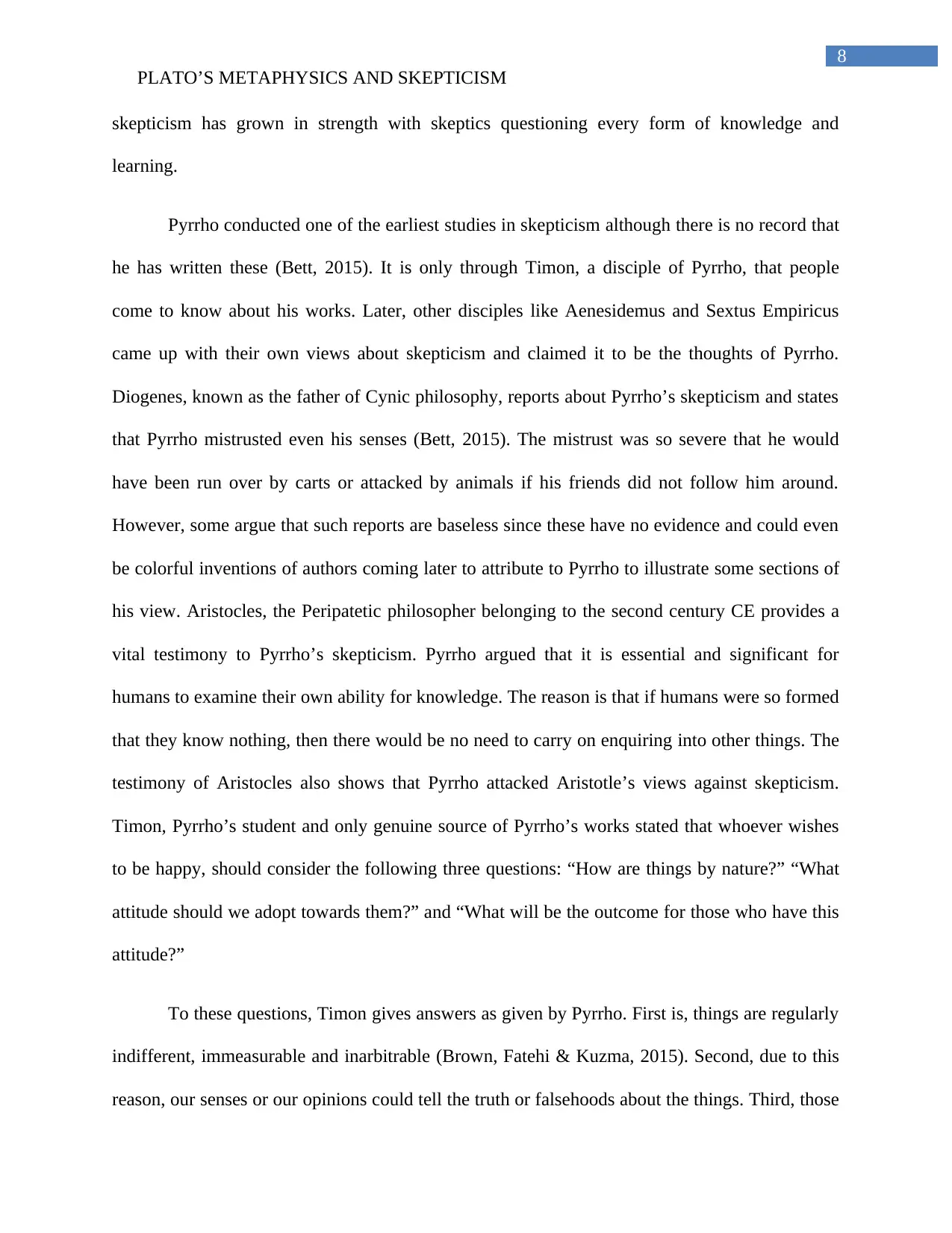
8
PLATO’S METAPHYSICS AND SKEPTICISM
skepticism has grown in strength with skeptics questioning every form of knowledge and
learning.
Pyrrho conducted one of the earliest studies in skepticism although there is no record that
he has written these (Bett, 2015). It is only through Timon, a disciple of Pyrrho, that people
come to know about his works. Later, other disciples like Aenesidemus and Sextus Empiricus
came up with their own views about skepticism and claimed it to be the thoughts of Pyrrho.
Diogenes, known as the father of Cynic philosophy, reports about Pyrrho’s skepticism and states
that Pyrrho mistrusted even his senses (Bett, 2015). The mistrust was so severe that he would
have been run over by carts or attacked by animals if his friends did not follow him around.
However, some argue that such reports are baseless since these have no evidence and could even
be colorful inventions of authors coming later to attribute to Pyrrho to illustrate some sections of
his view. Aristocles, the Peripatetic philosopher belonging to the second century CE provides a
vital testimony to Pyrrho’s skepticism. Pyrrho argued that it is essential and significant for
humans to examine their own ability for knowledge. The reason is that if humans were so formed
that they know nothing, then there would be no need to carry on enquiring into other things. The
testimony of Aristocles also shows that Pyrrho attacked Aristotle’s views against skepticism.
Timon, Pyrrho’s student and only genuine source of Pyrrho’s works stated that whoever wishes
to be happy, should consider the following three questions: “How are things by nature?” “What
attitude should we adopt towards them?” and “What will be the outcome for those who have this
attitude?”
To these questions, Timon gives answers as given by Pyrrho. First is, things are regularly
indifferent, immeasurable and inarbitrable (Brown, Fatehi & Kuzma, 2015). Second, due to this
reason, our senses or our opinions could tell the truth or falsehoods about the things. Third, those
PLATO’S METAPHYSICS AND SKEPTICISM
skepticism has grown in strength with skeptics questioning every form of knowledge and
learning.
Pyrrho conducted one of the earliest studies in skepticism although there is no record that
he has written these (Bett, 2015). It is only through Timon, a disciple of Pyrrho, that people
come to know about his works. Later, other disciples like Aenesidemus and Sextus Empiricus
came up with their own views about skepticism and claimed it to be the thoughts of Pyrrho.
Diogenes, known as the father of Cynic philosophy, reports about Pyrrho’s skepticism and states
that Pyrrho mistrusted even his senses (Bett, 2015). The mistrust was so severe that he would
have been run over by carts or attacked by animals if his friends did not follow him around.
However, some argue that such reports are baseless since these have no evidence and could even
be colorful inventions of authors coming later to attribute to Pyrrho to illustrate some sections of
his view. Aristocles, the Peripatetic philosopher belonging to the second century CE provides a
vital testimony to Pyrrho’s skepticism. Pyrrho argued that it is essential and significant for
humans to examine their own ability for knowledge. The reason is that if humans were so formed
that they know nothing, then there would be no need to carry on enquiring into other things. The
testimony of Aristocles also shows that Pyrrho attacked Aristotle’s views against skepticism.
Timon, Pyrrho’s student and only genuine source of Pyrrho’s works stated that whoever wishes
to be happy, should consider the following three questions: “How are things by nature?” “What
attitude should we adopt towards them?” and “What will be the outcome for those who have this
attitude?”
To these questions, Timon gives answers as given by Pyrrho. First is, things are regularly
indifferent, immeasurable and inarbitrable (Brown, Fatehi & Kuzma, 2015). Second, due to this
reason, our senses or our opinions could tell the truth or falsehoods about the things. Third, those
⊘ This is a preview!⊘
Do you want full access?
Subscribe today to unlock all pages.

Trusted by 1+ million students worldwide
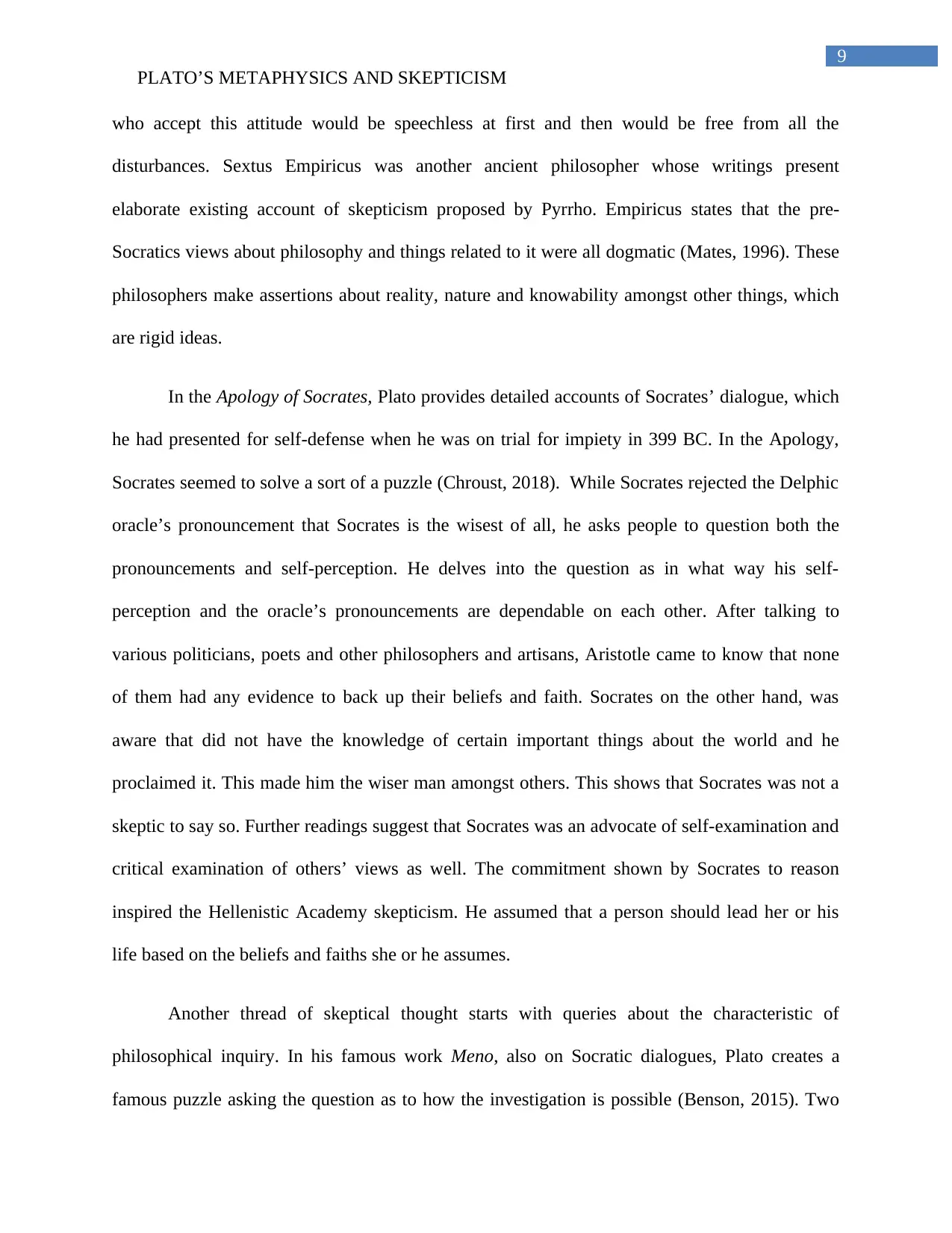
9
PLATO’S METAPHYSICS AND SKEPTICISM
who accept this attitude would be speechless at first and then would be free from all the
disturbances. Sextus Empiricus was another ancient philosopher whose writings present
elaborate existing account of skepticism proposed by Pyrrho. Empiricus states that the pre-
Socratics views about philosophy and things related to it were all dogmatic (Mates, 1996). These
philosophers make assertions about reality, nature and knowability amongst other things, which
are rigid ideas.
In the Apology of Socrates, Plato provides detailed accounts of Socrates’ dialogue, which
he had presented for self-defense when he was on trial for impiety in 399 BC. In the Apology,
Socrates seemed to solve a sort of a puzzle (Chroust, 2018). While Socrates rejected the Delphic
oracle’s pronouncement that Socrates is the wisest of all, he asks people to question both the
pronouncements and self-perception. He delves into the question as in what way his self-
perception and the oracle’s pronouncements are dependable on each other. After talking to
various politicians, poets and other philosophers and artisans, Aristotle came to know that none
of them had any evidence to back up their beliefs and faith. Socrates on the other hand, was
aware that did not have the knowledge of certain important things about the world and he
proclaimed it. This made him the wiser man amongst others. This shows that Socrates was not a
skeptic to say so. Further readings suggest that Socrates was an advocate of self-examination and
critical examination of others’ views as well. The commitment shown by Socrates to reason
inspired the Hellenistic Academy skepticism. He assumed that a person should lead her or his
life based on the beliefs and faiths she or he assumes.
Another thread of skeptical thought starts with queries about the characteristic of
philosophical inquiry. In his famous work Meno, also on Socratic dialogues, Plato creates a
famous puzzle asking the question as to how the investigation is possible (Benson, 2015). Two
PLATO’S METAPHYSICS AND SKEPTICISM
who accept this attitude would be speechless at first and then would be free from all the
disturbances. Sextus Empiricus was another ancient philosopher whose writings present
elaborate existing account of skepticism proposed by Pyrrho. Empiricus states that the pre-
Socratics views about philosophy and things related to it were all dogmatic (Mates, 1996). These
philosophers make assertions about reality, nature and knowability amongst other things, which
are rigid ideas.
In the Apology of Socrates, Plato provides detailed accounts of Socrates’ dialogue, which
he had presented for self-defense when he was on trial for impiety in 399 BC. In the Apology,
Socrates seemed to solve a sort of a puzzle (Chroust, 2018). While Socrates rejected the Delphic
oracle’s pronouncement that Socrates is the wisest of all, he asks people to question both the
pronouncements and self-perception. He delves into the question as in what way his self-
perception and the oracle’s pronouncements are dependable on each other. After talking to
various politicians, poets and other philosophers and artisans, Aristotle came to know that none
of them had any evidence to back up their beliefs and faith. Socrates on the other hand, was
aware that did not have the knowledge of certain important things about the world and he
proclaimed it. This made him the wiser man amongst others. This shows that Socrates was not a
skeptic to say so. Further readings suggest that Socrates was an advocate of self-examination and
critical examination of others’ views as well. The commitment shown by Socrates to reason
inspired the Hellenistic Academy skepticism. He assumed that a person should lead her or his
life based on the beliefs and faiths she or he assumes.
Another thread of skeptical thought starts with queries about the characteristic of
philosophical inquiry. In his famous work Meno, also on Socratic dialogues, Plato creates a
famous puzzle asking the question as to how the investigation is possible (Benson, 2015). Two
Paraphrase This Document
Need a fresh take? Get an instant paraphrase of this document with our AI Paraphraser
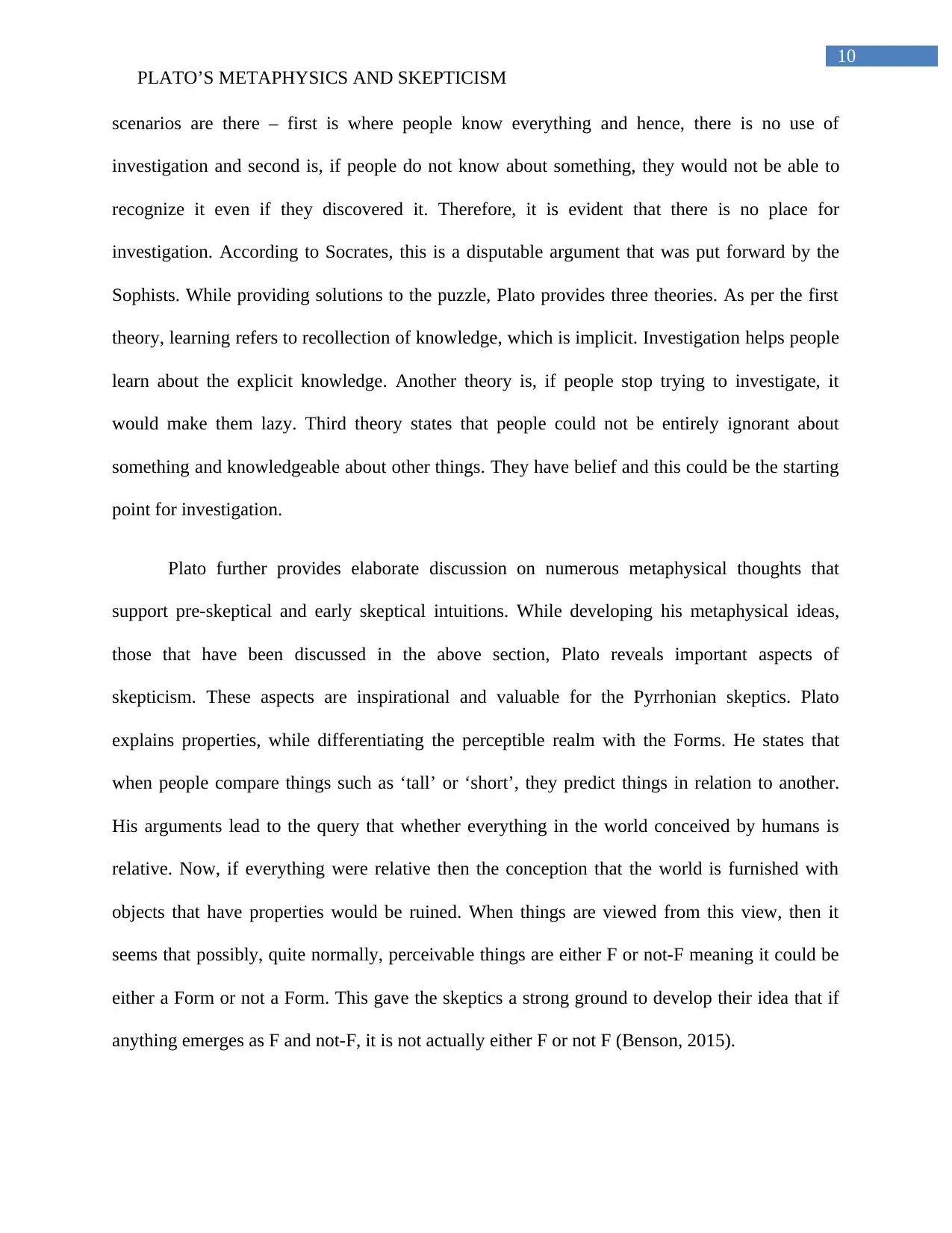
10
PLATO’S METAPHYSICS AND SKEPTICISM
scenarios are there – first is where people know everything and hence, there is no use of
investigation and second is, if people do not know about something, they would not be able to
recognize it even if they discovered it. Therefore, it is evident that there is no place for
investigation. According to Socrates, this is a disputable argument that was put forward by the
Sophists. While providing solutions to the puzzle, Plato provides three theories. As per the first
theory, learning refers to recollection of knowledge, which is implicit. Investigation helps people
learn about the explicit knowledge. Another theory is, if people stop trying to investigate, it
would make them lazy. Third theory states that people could not be entirely ignorant about
something and knowledgeable about other things. They have belief and this could be the starting
point for investigation.
Plato further provides elaborate discussion on numerous metaphysical thoughts that
support pre-skeptical and early skeptical intuitions. While developing his metaphysical ideas,
those that have been discussed in the above section, Plato reveals important aspects of
skepticism. These aspects are inspirational and valuable for the Pyrrhonian skeptics. Plato
explains properties, while differentiating the perceptible realm with the Forms. He states that
when people compare things such as ‘tall’ or ‘short’, they predict things in relation to another.
His arguments lead to the query that whether everything in the world conceived by humans is
relative. Now, if everything were relative then the conception that the world is furnished with
objects that have properties would be ruined. When things are viewed from this view, then it
seems that possibly, quite normally, perceivable things are either F or not-F meaning it could be
either a Form or not a Form. This gave the skeptics a strong ground to develop their idea that if
anything emerges as F and not-F, it is not actually either F or not F (Benson, 2015).
PLATO’S METAPHYSICS AND SKEPTICISM
scenarios are there – first is where people know everything and hence, there is no use of
investigation and second is, if people do not know about something, they would not be able to
recognize it even if they discovered it. Therefore, it is evident that there is no place for
investigation. According to Socrates, this is a disputable argument that was put forward by the
Sophists. While providing solutions to the puzzle, Plato provides three theories. As per the first
theory, learning refers to recollection of knowledge, which is implicit. Investigation helps people
learn about the explicit knowledge. Another theory is, if people stop trying to investigate, it
would make them lazy. Third theory states that people could not be entirely ignorant about
something and knowledgeable about other things. They have belief and this could be the starting
point for investigation.
Plato further provides elaborate discussion on numerous metaphysical thoughts that
support pre-skeptical and early skeptical intuitions. While developing his metaphysical ideas,
those that have been discussed in the above section, Plato reveals important aspects of
skepticism. These aspects are inspirational and valuable for the Pyrrhonian skeptics. Plato
explains properties, while differentiating the perceptible realm with the Forms. He states that
when people compare things such as ‘tall’ or ‘short’, they predict things in relation to another.
His arguments lead to the query that whether everything in the world conceived by humans is
relative. Now, if everything were relative then the conception that the world is furnished with
objects that have properties would be ruined. When things are viewed from this view, then it
seems that possibly, quite normally, perceivable things are either F or not-F meaning it could be
either a Form or not a Form. This gave the skeptics a strong ground to develop their idea that if
anything emerges as F and not-F, it is not actually either F or not F (Benson, 2015).
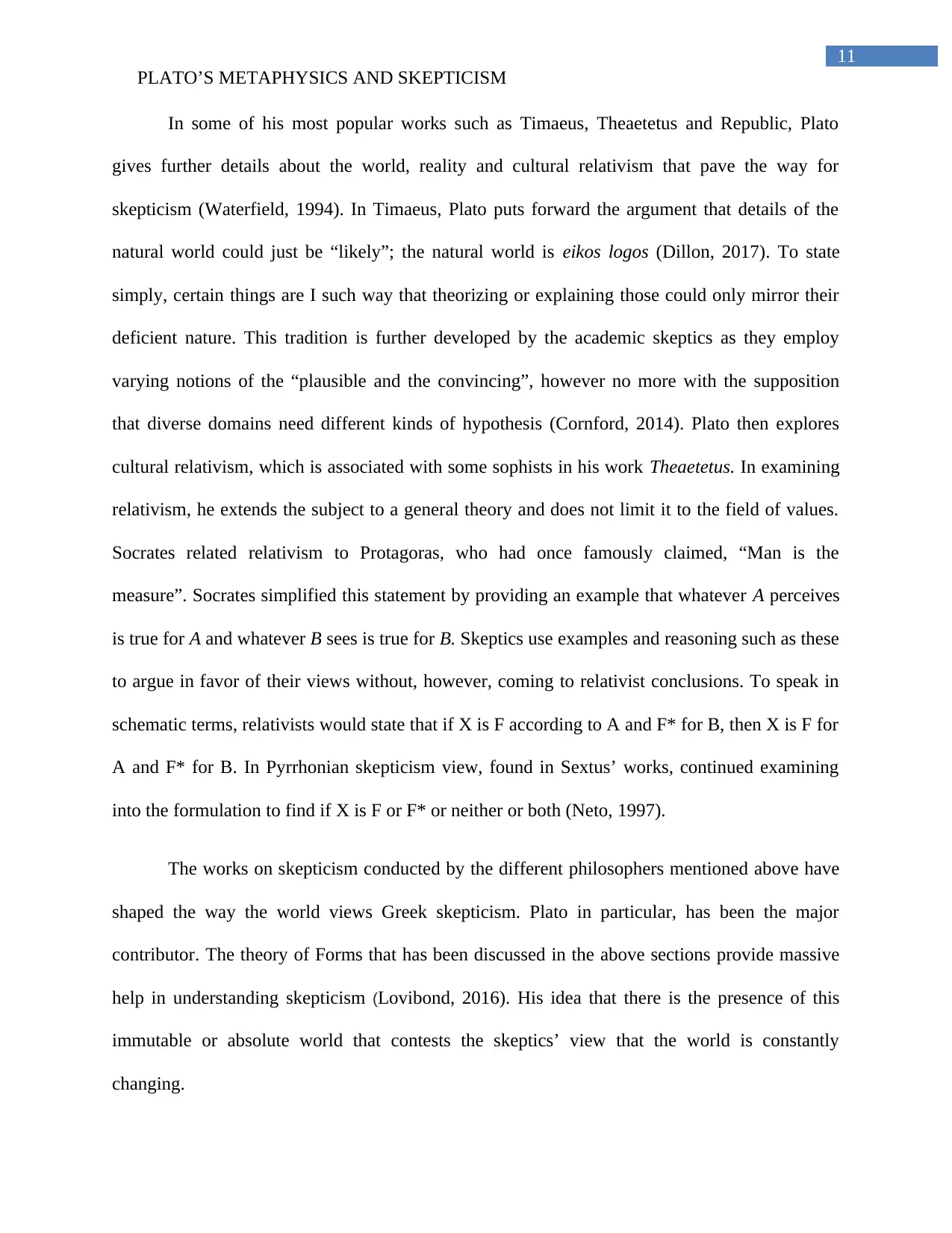
11
PLATO’S METAPHYSICS AND SKEPTICISM
In some of his most popular works such as Timaeus, Theaetetus and Republic, Plato
gives further details about the world, reality and cultural relativism that pave the way for
skepticism (Waterfield, 1994). In Timaeus, Plato puts forward the argument that details of the
natural world could just be “likely”; the natural world is eikos logos (Dillon, 2017). To state
simply, certain things are I such way that theorizing or explaining those could only mirror their
deficient nature. This tradition is further developed by the academic skeptics as they employ
varying notions of the “plausible and the convincing”, however no more with the supposition
that diverse domains need different kinds of hypothesis (Cornford, 2014). Plato then explores
cultural relativism, which is associated with some sophists in his work Theaetetus. In examining
relativism, he extends the subject to a general theory and does not limit it to the field of values.
Socrates related relativism to Protagoras, who had once famously claimed, “Man is the
measure”. Socrates simplified this statement by providing an example that whatever A perceives
is true for A and whatever B sees is true for B. Skeptics use examples and reasoning such as these
to argue in favor of their views without, however, coming to relativist conclusions. To speak in
schematic terms, relativists would state that if X is F according to A and F* for B, then X is F for
A and F* for B. In Pyrrhonian skepticism view, found in Sextus’ works, continued examining
into the formulation to find if X is F or F* or neither or both (Neto, 1997).
The works on skepticism conducted by the different philosophers mentioned above have
shaped the way the world views Greek skepticism. Plato in particular, has been the major
contributor. The theory of Forms that has been discussed in the above sections provide massive
help in understanding skepticism (Lovibond, 2016). His idea that there is the presence of this
immutable or absolute world that contests the skeptics’ view that the world is constantly
changing.
PLATO’S METAPHYSICS AND SKEPTICISM
In some of his most popular works such as Timaeus, Theaetetus and Republic, Plato
gives further details about the world, reality and cultural relativism that pave the way for
skepticism (Waterfield, 1994). In Timaeus, Plato puts forward the argument that details of the
natural world could just be “likely”; the natural world is eikos logos (Dillon, 2017). To state
simply, certain things are I such way that theorizing or explaining those could only mirror their
deficient nature. This tradition is further developed by the academic skeptics as they employ
varying notions of the “plausible and the convincing”, however no more with the supposition
that diverse domains need different kinds of hypothesis (Cornford, 2014). Plato then explores
cultural relativism, which is associated with some sophists in his work Theaetetus. In examining
relativism, he extends the subject to a general theory and does not limit it to the field of values.
Socrates related relativism to Protagoras, who had once famously claimed, “Man is the
measure”. Socrates simplified this statement by providing an example that whatever A perceives
is true for A and whatever B sees is true for B. Skeptics use examples and reasoning such as these
to argue in favor of their views without, however, coming to relativist conclusions. To speak in
schematic terms, relativists would state that if X is F according to A and F* for B, then X is F for
A and F* for B. In Pyrrhonian skepticism view, found in Sextus’ works, continued examining
into the formulation to find if X is F or F* or neither or both (Neto, 1997).
The works on skepticism conducted by the different philosophers mentioned above have
shaped the way the world views Greek skepticism. Plato in particular, has been the major
contributor. The theory of Forms that has been discussed in the above sections provide massive
help in understanding skepticism (Lovibond, 2016). His idea that there is the presence of this
immutable or absolute world that contests the skeptics’ view that the world is constantly
changing.
⊘ This is a preview!⊘
Do you want full access?
Subscribe today to unlock all pages.

Trusted by 1+ million students worldwide
1 out of 17
Related Documents
Your All-in-One AI-Powered Toolkit for Academic Success.
+13062052269
info@desklib.com
Available 24*7 on WhatsApp / Email
![[object Object]](/_next/static/media/star-bottom.7253800d.svg)
Unlock your academic potential
Copyright © 2020–2025 A2Z Services. All Rights Reserved. Developed and managed by ZUCOL.





